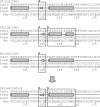Clinical and molecular observations of two fatal cases of rotavirus-associated enteritis in children in Italy
- PMID: 21525221
- PMCID: PMC3147829
- DOI: 10.1128/JCM.01358-10
Clinical and molecular observations of two fatal cases of rotavirus-associated enteritis in children in Italy
Abstract
Two fatal cases of infantile rotavirus enteritis occurred in northern Italy in 2005. Both children were severely dehydrated, and death was related to severe cerebral edema. Histological examination demonstrated extensive damage of the intestinal epithelium, villous atrophy or blunting, and macrophage infiltration. The two rotavirus strains were of the G1P[8] type and the long electropherotype. The 2005 G1P[8] rotaviruses differed in the NSP4, VP3, VP4, and VP7 genes from G1P[8] rotaviruses circulating in 2004, suggesting the onset of a new G1P[8] strain in the local population.
Figures




References
-
- Amador J. J., et al. 2008. Outbreak of rotavirus gastroenteritis with high mortality, Nicaragua, 2005. Rev. Panam. Salud Publica 23:277–284 - PubMed
-
- Ball J. M., Tian P., Zeng C. Q., Morris A. P., Estes M. K. 1996. Age-dependent diarrhea induced by a rotaviral nonstructural glycoprotein. Science 272:101–104 - PubMed
-
- Bányai K., et al. 2009. Trends in the epidemiology of human G1P[8] rotaviruses: a Hungarian study. J. Infect. Dis. 200:S222–S227 - PubMed
Publication types
MeSH terms
Substances
Associated data
- Actions
- Actions
- Actions
- Actions
- Actions
- Actions
- Actions
- Actions
- Actions
- Actions
- Actions
- Actions
- Actions
- Actions
- Actions
- Actions
- Actions
- Actions
- Actions
- Actions
- Actions
- Actions
- Actions
- Actions
- Actions
- Actions
- Actions
- Actions
- Actions
- Actions
- Actions
- Actions
- Actions
- Actions
- Actions
- Actions
- Actions
- Actions
- Actions
- Actions
- Actions
- Actions
- Actions
- Actions
- Actions
- Actions
- Actions
- Actions
- Actions
- Actions
- Actions
- Actions
LinkOut - more resources
Full Text Sources
Medical

